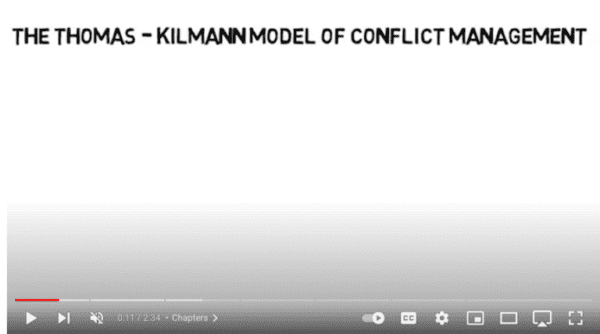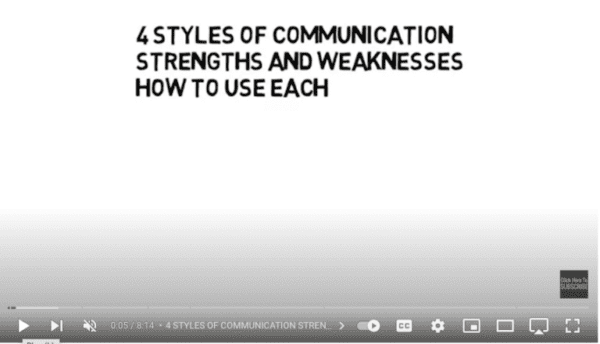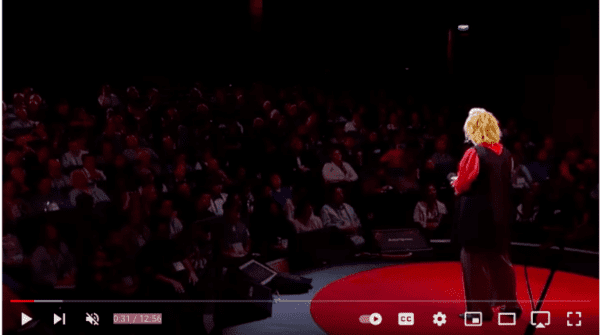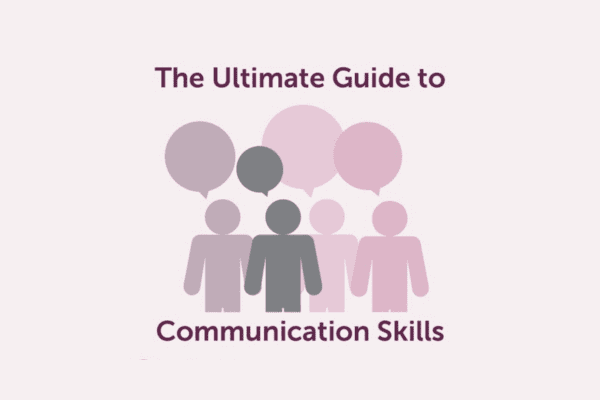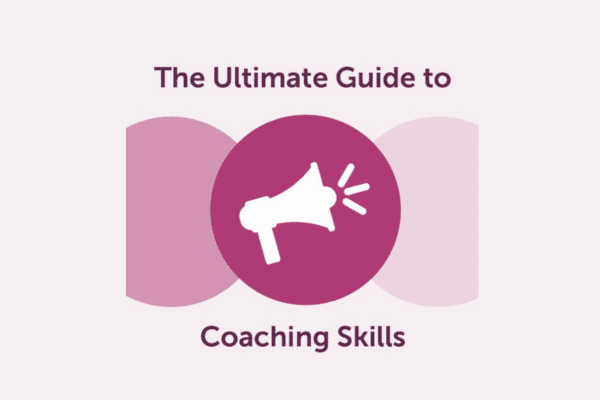Why is it Important to Have Healthy Conflict Resolution Skills?
What’s the deal with conflict resolution skills in today’s working world? Well, conflict at work is inevitable. Yet, it often creates an unpleasant working environment for you and your team. Being able to manage conflict is an essential skill. If you don’t, your team will likely lose motivation. Ultimately, over time, workplace grievances will increase.
People won’t stay in a working environment that is hostile and they will look to leave. Therefore, good skills in conflict resolution can help your team work better together. Moreover, the business will benefit from an increase in productivity and a decrease in staff turnover.
Read on to learn why workplace conflict arises, how to problem solve, and how to adopt great skills in conflict resolution in the workplace for when conflict does inevitably arise. Poor skills for resolving conflict can play a huge part in this.

This Ultimate Guide will Cover:
- 1- Why is it Important to Have Good Conflict Resolution Skills? (Above)
- 2- What are Conflict Resolution Skills?
- 3- Workplace Conflict
- 4- Six Causes of Conflict at Work
- 5- Conflict Intensity Levels
- 6- Preventing Conflict at Work: How to Notice the Early Signs
- 7- What Are the Strategies for Conflict Resolution?
- 8- Five Ways to Promote Healthy Conflict
- 9- Conflict Management Skills: 8 Steps for Conflict Resolution
- 10- Conflict Management Models
- 11- How Do You Resolve Conflict in a Team?
- 12- How to Improve Your Conflict Resolution Skills
- 13- Further Reading and Resources
2) What are Conflict Resolution Skills?
The Oxford Dictionary definition of conflict is ‘A serious incompatibility between two or more opinions, principles or interests’.
This definition is interesting because it doesn’t imply that this is a disagreement between two people or groups of people. This is experiencing conflict within one person about different areas of their life. It implies that conflict can be internal.
Another definition, by Harvard Law School, is ‘Conflict refers to some form of friction, or discord arising within a group when the beliefs or actions of one or more members of the group are either resisted by or unacceptable to one or more members of another group’. This one sounds more like a conflict in the business world, where teams of people have to work together towards a common goal.
Conflict resolution is, ‘The methods and processes involved in facilitating the peaceful ending of conflict’. Conflict management, however, is how to navigate through conflict to get to a resolution. The management part recognises that conflict is inevitable and sometimes healthy. In order to do this, conflict resolution skills play a key part.
Also, this one-minute video will give you a basic understanding of conflict management:
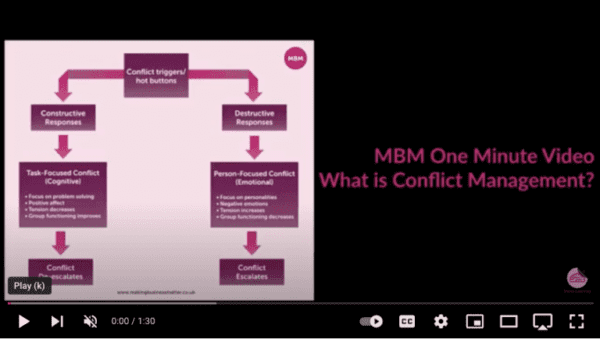
3) Workplace Conflict
Let’s look at how we would recognise healthy conflict, what causes negative conflict and the skills needed to peacefully manage and end the conflict at work using skills for resolving conflict in the workplace and conflict resolution relationship skills.

Conflict, when expressed incorrectly, can lead to violence or ruin professional relationships. Using conflict resolution relationship skills is key to ensuring this does not happen. If there are poor conflict resolution skills then it will inevitably cause issues within a relationship.
4) Causes of Conflict at Work
Lots of things can cause conflict at work. See six conflict resolution skills examples and their main causes below:
The 6 Causes of Conflict:
#1- Different Personalities
Different people have different values, work ethics, work styles and beliefs, which can all lead to conflict between people. In short, there are some personalities that will just never get along. Furthermore, pressure can also bring out the worst in people. This makes people snappy and more easily offended.
#2- High Expectations
When expectations of staff are unrealistic or feel unattainable, it makes for a very charged environment. People feel unable to meet their targets. This makes them worry about their job security and the environment can become unfriendly.
#3- Fairness at Work
When the values of the business and the rules are not clear, people can feel unsettled. This can lead to people not being treated equally and not knowing what leadership and management expect of them. For instance, punishing one person for something and letting another off can lead to conflict.
#4- Unresolved Problems
When problems that start small or requests from people are ignored, this can lead to conflict and shows poor skills for resolving conflict.
#5- Increase in Workload
Sometimes an increase in workload on an already fragile team can increase conflict at work.
#6- Miscommunication
A large number of issues come up simply through people not communicating properly such as poor skills in conflict resolution. Things can easily get lost in translation. Moreover, people working towards different goals can also lead to conflict; one person’s plans can take away from their colleague’s. Working towards a shared goal encourages teamwork and builds relationships.
5) Conflict Intensity Levels
Conflicts in a business environment vary widely in intensity. Below, is a list of the different levels of conflict that may be present in the workplace. As the level escalates, the need for effective conflict management increases.
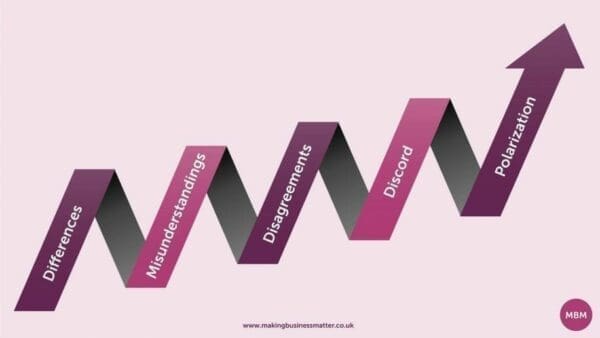
Level 1: Differences
On this level, parties only hold different perspectives but are aware of the other party’s interests and mindset. Differences rarely affect productivity or working relationships.
Level 2: Misunderstandings
This occurs when opposing parties interpret situations differently. There is a need to check for misunderstandings early in the conflict resolution process to avoid escalation.
Level 3: Disagreements
Disagreements occur when people see a situation differently even though they understand the other’s position. The discomfort is that the other party is not in agreement. Often, the parties instigate creative thinking.
Level 4: Discord
Conflicts reach the level of discord when parties start to avoid, criticise and block each other. The relationship between the parties is negatively affected at this level.
Level 5: Polarisation
Parties use destructive behaviours when conflict rises. Other parties may begin to recruit others to join their cause, thus leading to severely damaged relationships.
6) Preventing Conflict at Work: How to Notice the Early Signs
The Importance of Conflict Resolution Skills
Once we know where the conflict might be coming from, we can put steps in place to do something about it and stop it from escalating. What about trying to prevent conflict from becoming a problem in the first place? Noticing these early signs is important. It could be caused by a manager which is why Conflict resolution skills for managers play a key role in ensuring a healthy working environment.
1- Body Language
People who might be bottling up their emotions and feeling upset about something can change their body language. Crossing their arms, avoiding eye contact, their position and frowning are signs that someone isn’t happy. It is usually subtle, but if you know your staff well you can pick up on these cues and do something about it before it becomes a problem.

2- Cliques
You want your team to work well together. However, sometimes smaller groups can form in the larger group. This can lead to people feeling left out or even bullied. If you notice smaller cliques forming, spend some time understanding why. If it gets too unprofessional, a seating adjustment can expose people to other team members that they don’t know as well and lead to new relationships forming. Also, think about productivity, if people are sitting near someone who distracts them, their work performance could suffer. (Check out our article on team exercises to resolve conflict).
3- Change in Productivity
When people are not happy or comfortable in the work environment their productivity can suffer. They might be more focused on their feelings of discomfort and not on their work. If you start to notice changes in productivity, keep an eye on why that might be so you can have conversations early.
4- Complaints
People who aren’t happy at work are more likely to complain about things. This is possibly an early sign of conflict. Listen out for people who start complaining or are complaining more than they have before.
5- Increased Absence
Some people will phone in sick if the environment becomes unbearable for them to work in. They will avoid and not face the problem to find a solution. When staff members are off sick and return to work, an open conversation at their return to work meeting is important. You can find out the reason for the absence and do something about it.
6- High Staff Turnover
If a high number of employees start to leave, this is a big red flag! There is something wrong that needs to be rectified quickly through proactive human resource planning. Moving jobs is a big disruption for people. Losing staff members changes the team dynamic and costs the company time and money. It takes time to find and train a new member of staff. Consequently, good staff retention is a sign of a happy workplace.
7) What are the Strategies for Conflict Resolution Skills?
Prevention is better than cure’.
This is a good approach when dealing with conflict. Moreover, don’t let it become a serious problem. Be mindful and aware and do something, sooner than later. Now the question is, how do we manage conflict? It’s all about workplace culture. This shows the importance of skills in conflict resolution.
#1- Have a Culture of Respect
Not everyone is going to get along all the time and some personalities just clash. This is normal in the world of work as it is in life. However, that does not mean that people can treat each other badly. A polite culture at work is essential.
As a leader, you can take notice of people who don’t get along and where possible don’t place them on the same tasks. Keep in mind that moving people around to different teams might make the operation run more smoothly. If this isn’t possible people need to learn to agree to disagree and not let it affect their work. Being professional and grown-up means working with people we wouldn’t necessarily be friends with.
#2- Have a Culture of Open Conversation
Often, when there is conflict it can relate back to misunderstandings and miscommunications. An example of this might be that a member of the team is struggling with their workload. For instance, they may feel like tasks haven’t been delegated equally when they see other colleagues managing well. In short, they feel unfairly treated.
Maybe this is true, and the managers need to distribute work better. It could also be not true. Simply that the colleagues managing well know some time-saving tips and tricks. This would be helpful to share with their colleague who is struggling. Simple things can make a difference when the problem is properly understood.
Encouraging open conversation also means you will get to know your staff better. This helps to understand their workload. When staff feel like their manager is on their side and willing to advocate for them it makes for a happier work environment. They don’t feel like they need to bottle things up. Being open and honest helps to avoid conflict. Overworked staff and ignorant managers are a recipe for disaster!
#3- Have a Culture of Fairness
A sure way to create conflict at work is to not treat people equally. When one person gets away with things while another doesn’t, this favouritism can cause conflict. Being resented and treated differently is difficult for the favourite. This starts two problems. Firstly, the favourite person will be unhappy at being ostracised. Secondly, the people being treated differently by management will feel unhappy.
In the end, everyone is unhappy and the work environment is very unpleasant.
#4- Have a Proactive Culture
Resolve things before they become a problem. When people raise problems, investigate and resolve them as a priority. Happy staff are more productive staff. Letting things stew only causes even more conflict and problems later on.
Excuse the Interruption, But Here’s a Little Bit About Us…
We are the soft skills training provider to the UK Grocery Industry, helping Suppliers to win more business. They choose us because of our money-back guarantee, our relevant experience, and because we make their learning stick.
Find out how you can achieve behavioural change and have 5-level training evaluation reports – Click on the button below:

8) Five Ways to Promote Healthy Conflict
We’ve discussed some of the negative aspects of conflict at work. But, are there times when conflict is good?If you are working in a team where there is never any disagreement or conflict, this might be a bad thing. Possibly people won’t feel they can express their opinions. Another possibility is that people don’t care enough to argue for what they believe in. If a team knows how to disagree in a constructive and healthy way, this leads to better teamwork and better productivity.
To make a change and move things forward, discussion and debate are necessary. When you have a group of people with different values and opinions, conflict seems inevitable. Handling differences properly can lead to better relationships and productivity.
There are key things that are part of the business culture to make healthy conflict work for you:
#1- People Need to Know Each Other
Being familiar with work colleagues on a more personal level makes people more trusting of each other. Furthermore, they are less likely to assume that disagreement or different ideas are malicious. It will be more balanced.
#2- Only the Facts
When a debate starts to attack people’s personality traits, it is no longer healthy. Debate at work is about productivity, workload, and work processes, not about attacking an individual.
#3- Transparency
There are no hidden agendas in healthy conflict and debate. Everyone needs to bring their ideas to the table and know that open discussion is being had. Trying to make decisions without all the facts is difficult and people don’t have the right level of trust when there isn’t transparency.
#4- Everyone Gets a Say
All members have a chance to talk about and consider their concerns. Making decisions by factoring in everything means people are more likely to commit to the final decision.
#5- Full Commitment to Decisions
When decisions come out of healthy conflict and debate, everyone needs to action those decisions. If someone says ‘yes’ and then walks away and does something else, it undermines the group activity.
9) Conflict Management Skills: Eight Steps for Conflict-Resolution Skills
It’s important to understand the role of assertiveness and cooperativeness in conflict management
To manage conflict you need to be able to have an open conversation, stay unemotional and don’t attack the other person’s character. You must choose your words wisely, discuss, compromise, list and plan for improvements. Finally, look to make changes and meet regularly to track any improvements. Always remember to encourage and praise good behaviour.
Steps to Follow to Resolve a Conflict Using Conflict Resolution Skills
The following eight conflict resolution skills examples will help you address and deal with conflict when it arises:
#1. Talk to the Person:
Arrange to meet with them when it is convenient in a place that is private. A lot of conflict and friction stems from misunderstanding. Discussing things leads to people’s perceptions being known and understood. This is the first step to resolution. People also get to know each other which reduces future conflict.
#2. Discuss the Event, Not the Personality:
How you phrase your concern changes how the other person receives it. Saying ‘When you do this’, directs the complaint at the person. Instead, you should say, ‘When this happens’. That makes the conversation about the issue. When people feel attacked, they won’t be as receptive to open conversation. Feeling defensive is going to change the outcome of the conversation in a negative way. Give specific examples so the person can make a connection. Being too general won’t help your cause.
#3. Use Neutral Language:
In anger, people tend to use emotional language. Emotive language is words that cause an emotional response in someone. Try to get your point across using neutral language. Stick to the facts. Words that mean the same thing expressed emotively change the tone of what you are saying.
For example, the word ‘reduced’ is a neutral expression, whereas the word ‘slashed’ is emotive. They can mean the same thing, but one causes a reaction in the listener. Words that mean the same thing also have an association that is positive or negative. Calling someone ‘meticulous to detail’, for example, is a positive comment. Whereas telling someone they are ‘nitpicking’ is not. Think about the language you use and the reaction it causes.
#4. Listen to Understand, Not to Reply:
Often, during a conversation, we are thinking about our reply instead of listening to the other person and engaging with what is being said. Active listening gets better results. Repeating information back as you have understood it is a good technique to show the other person that you are paying attention. Ask questions, but avoid interrupting the person. If both parties are able to express their story fully, this aids discussion and moves things forward.
#5. Clearly Identify the Problem:
Discuss the problem fully and summarise the key points of concern. Make sure that both parties agree with the summary so the plan going forward is mutual. Clarify any disagreement here so the problems identified are agreed on. If both parties don’t agree, they won’t commit to fixing something they don’t see as broken. If there are many issues, prioritise the list and work through the most important or most influential downwards. However, with only one or two issues, this is less relevant.
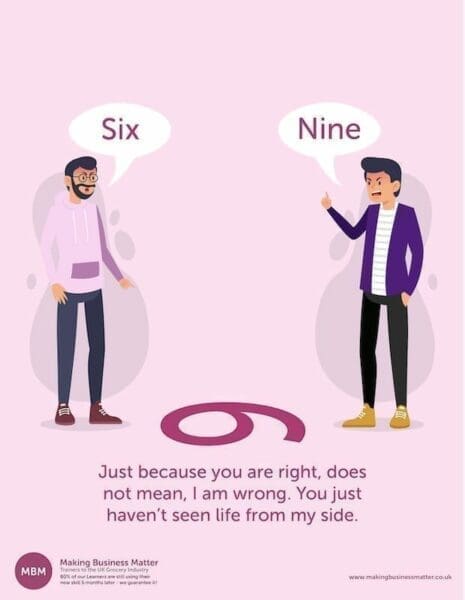
When both parties see different things and have different perspectives, it can be challenging to clearly identify the problem in conflict resolution. However, it is crucial to work towards a shared understanding of the problem to effectively resolve the conflict.

#6. Willing to Compromise:
Compromise is a lose-lose scenario. Neither party gets exactly what they want and, therefore, needs to give up something. If you are unwilling to compromise you will struggle with managing conflict.
#7. Plan:
Each point on the conflict list needs a plan of action to improve it. Again develop the plan between both parties. Agreeing to a plan that everyone is on-board with gets a better commitment and better outcomes. Your plan should also include the date of the next meeting to track any progress and adjust the plans if required. To make healthy changes, stick to your commitment. Sometimes things don’t go according to plan and things need to change. Setbacks are overcome with both parties committed to a good outcome.
#8. Be Complimentary:
As things change and improve, acknowledge it. Change is difficult for most people, praise behaviour you want to see repeated.
10) Conflict Management Skills Models
Everyone has a conflict management style they naturally follow. Knowing yours and the style of your team members is helpful. When people know their style, if it isn’t a good style, they can work on it. If you don’t know your own style, you can take a quick quiz online to find out.
1. Thomas-Kilmann Conflict Mode Instrument (TKI)
People ask, what are the 5 conflict management styles? The Thomas-Kilmann Conflict Mode Instrument (TKI) helps measure how a person behaves when presented with a conflict situation. This model looks at five ways of handling conflict in two dimensions, assertiveness and cooperation.

#1- Accommodating
Being on the high end of cooperation and the low end of assertiveness, you are assisting to a high degree. Potentially putting your own needs on the back burner with this approach and helping others to reach their goals.
When does this approach work? If the other person is an expert in the area being discussed it makes sense to listen to and act on their point of view.
When does this approach not work? Always being accommodating leaves your needs unmet and your own personal goals can suffer. Balance is key here. Know when to bow to expert opinion and when to stand up for what you think.
#2- Avoiding
Being on the low end of cooperation and the low end of assertiveness, you are not assisting or being assertive. Avoiding problems means nothing is moving forward. Your goals and the other person’s goals are both not being met.
When does this approach work? It works if the issue isn’t important to the big picture and leaving it unresolved doesn’t cause a problem. Moreover, dealing with it would take a lot of effort. Also, when in a highly emotional situation where people need space to think.
When does this approach not work? If you are avoiding big issues this won’t move anything forward. Ignoring problems won’t make them go away.
#3- Competing
Being on the high end of assertiveness and the low end of cooperation, you are being very assertive. Competing means one person wins and another loses.
When does this approach work? In emergency situations where there isn’t time to have long discussions. It is decisive and quick. When does this approach not work? In day-to-day work life, this approach comes across as bossy. Team members won’t tolerate this long term.
#4- Collaborating
On the high end of assertiveness and the high end of cooperation, you are being assertive and assisting. This win-win approach meets both groups’ goals.
When does this approach work? In complicated problems where everyone’s feedback forms the solution. You need time to use this approach. Consensus takes time and effort.
When does this approach not work? When the team doesn’t trust each other or work well together this is difficult to do.
#5- Compromise
Being right in the middle of the scale, this is when both parties lose out. A lose-lose situation.
When does this approach work? If there isn’t time to collaborate and putting a temporary solution in place is the answer. This compromise covers the problem until a collaborative solution is found.
When does this approach not work? Using this approach too often as an easy way out is not sustainable in the long term. It also needs a level of trust and the ability to work together.
Which of the Five Conflict Modes Do You Favour?
You can click the image below view a higher resolution:
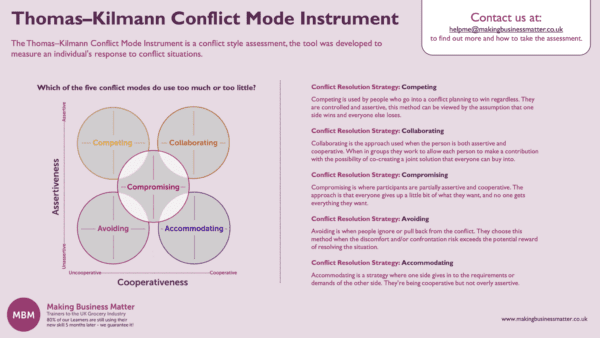
Understanding the Thomas-Kilmann Conflict Mode Instrument helps with better conflict resolution.
Even more, watch this video showing how two painters could use this model to solve conflict in five different ways. Click the image below to watch the video:
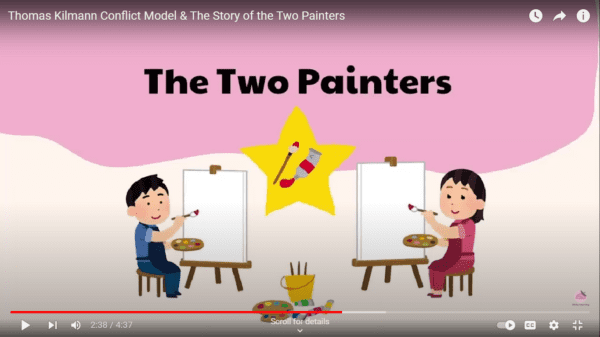
2. Dynamic Conflict Model
The dynamic conflict model describes how people’s response affects conflict resolution both negatively and positively. Craig Runde and Tim Flanagan developed the Dynamic Conflict Model and published it in their 2007 book, Becoming a Competent Conflict Leader. In it, they broke down conflicts into two main categories: Cognitive Conflicts and Affective Conflicts.
Cognitive conflicts focus on problem-solving hence the parties are tasked-focused. Furthermore, due to their nature, cognitive conflicts hardly escalate into dysfunctional conflicts.
Affective conflicts are focused on the person and hence emotionally charged. In that case, conflict escalation is likely and often leads to reduced collaboration and severed relationships.
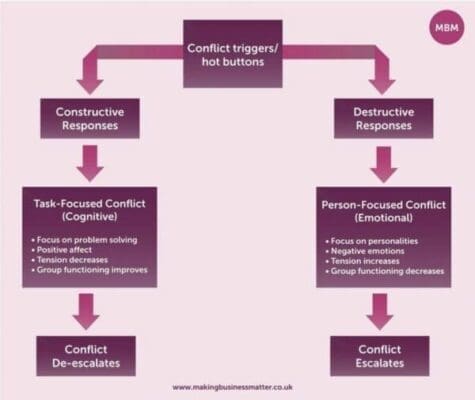
Constructive responses keep those managing conflict focused on issues, thus reducing tension and stopping the escalation. However, destructive responses, centred on personalities, make things worse. Responses to a conflict can either be active or passive. Active responses are those in which a person takes explicit action in response to provocation. Passive responses, by comparison, are those in which the individual refrains from acting.
11) How Do You Resolve Conflict in a Team Using Conflict Resolution Skills?
Communication is so important in resolving team conflict. Furthermore, improving communication will help with the development of effective skills for resolving conflict. It is worth getting team members to know their own communication styles. People with different communication styles could clash. Get your team members to take an online test to understand their style better.
There are many online versions and paper versions too. Depending on the training format, pick what suits your needs. Once the team’s styles are found, everyone can learn the best ways to communicate.
There are two separate categories of communication which are important for conflict resolution. One focuses on people’s communication styles when talking to other people. The other looks at how people process information and engage.
Individual Communication Styles
There are four categories of communication styles:
#1- Passive Communicators
A passive person focuses on pleasing others to avoid conflict. It’s about ignoring their own needs and putting others’ needs first. A passive person is unlikely to raise problems or concerns. Things build up and lead to tension. Even passive people have their limits though. It takes a long time to reach it, but when they do they may have outbursts. This behaviour is shocking because it is so out of character. The reaction to the situation might be exaggerated because it is the last straw and not just that particular incident that is causing the problem.
How to Spot a Passive Person
They won’t express their opinions or thoughts. For instance, they are apologetic and won’t speak out or take responsibility for making decisions. Common behavioural traits of passive people are avoiding eye contact, being softly spoken and acting submissively or like a victim.
Communicating with a passive person can make people feel irritated. Indecision and no opinion are tiring to work with. People get tired eventually and stop asking the passive person what they think. Often they become left out.
#2- Aggressive Communicators
An aggressive person only cares about their own goals and feelings. They don’t consider others and sometimes use verbal abuse to get their way. The focus on winning leads to walking over other people. This style doesn’t work because people react to how the information is delivered instead of the real message.
How to Spot an Aggressive Person
The aggressive person is intimidating, abrasive, unpredictable and just a bully. They speak loudly, get in people’s space, have a frown or glare on their faces and intimidate others.
Communicating with an aggressive person makes people feel hurt or embarrassed. People with good self-esteem feel aggressive and communication fails. People with low self-esteem feel hurt and embarrassed because they feel like it is their fault. This style doesn’t work because people won’t talk openly with someone aggressive in case they blow up. Problems aren’t talked about and things build up.
#3- Passive Aggressive Communicators
A mixture of the last two styles we looked at, passive-aggressive people are passive on the surface but act aggressively behind the scenes. This is sly behaviour. They feel powerless and act out, even if they hurt themselves in the process.
How to Spot a Passive-Aggressive Person
Passive-aggressive people are often sly and devious. They can be two-faced and engage in gossip. They will seem to take a back seat, but then make underhand remarks about it.
Communicating with a passive aggressive person makes people feel confused. They don’t understand why the person won’t help themselves and be honest and open. The full story is never laid out and it is difficult to make plans under these circumstances. Getting employees to recognise that they are passive aggressive can be tough. It takes self-awareness to recognise it and to do something about it.
This style of communication, when taken a step further, becomes manipulative communication. This is even more secretive. Their intentions are hidden better and they use guilt to get what they want. People working with a manipulative person often feel guilty. Not knowing where you stand is exhausting and this leads to a charged environment and conflict.
#4- Assertive Communicators
This is the preferred communication style. Assertive people get their points and values across without stepping on anyone else’s point of view. Assertive people have good self-esteem and know their value. This is a respectful way to communicate.
How to Spot an Assertive Person
They are direct and open about their needs and wants. Decision-makers that don’t hurt other people in the process of achieving their goals.
Communicating with an assertive person makes people feel at ease. All the cards are on the table without any games or hidden agendas. Trust is important in communication, making this style one of the better ones.
Running training with people around communication styles is a good way to get people thinking about their style. Being aware of their own style and being a better communicator makes the overall team communication better. Another way to think about communication is by saying things in a way that interests that person. If you know what catches people’s attention you can change how you talk to them to get the best out of conversations.
Engaging Styles
When people aren’t spoken to in a way that engages them, their mind wanders. Another outcome is there is an internal thought process about where the missing information is. This noise, or mind wander, can take their focus away from what is said. If you talk to people in a way that peaks and holds their interest, the outcome of the conversation is better. There are four engaging styles:
#1- Analytical
When talking to an analytical person, numbers, facts and data catch their attention. Talking in a vague way won’t get their attention. They will question why there aren’t any hard facts.
For example, if a manager told an analytical person that their goals hadn’t been met that week, this wouldn’t be enough to interest the analytical person. On the other hand, saying, ‘Our goal was missed by 5% this week.’ This is factual and makes analytical people more comfortable. Analytical people are less emotional and use unemotional language.
Sometimes, they can come off as stiff and uncaring. However, on the positive side, they have a good knowledge base. In the business world, this style works well.
#2- Personal
Personal communicators like emotional language. They like building a relationship with their colleagues. During information sharing, the focus is less on the content and more on how people feel about it. They like praise for a job well done, for themselves and the team. An informal approach and a focus on relationships work for personal people. On the one hand, however, people might feel this style is too informal and hippy-dippy. On a positive note, they are good at listening and resolving conflict.
#3- Intuitive
Intuitive people don’t need a lot of details. They want to know what the big picture looks like. To hold their attention, get to the point quickly by jumping to the anticipated outcome. When they see where the end point is, they are interested. This approach saves time, but sometimes the problem needs time to go through each step.
Intuitive people often don’t make the best teachers because they don’t go into the detail that people need when learning. This could be something to consider if you have intuitive engaged leading training.
#4- Functional
Functional communicators like the details that intuitive people hate. These people are very thorough and cover all the details. This does take more time, but things won’t be missed. As the communicator, they will struggle to hold the attention of everyone in the audience with this level of depth.
Communication and Engagement
You can see why some of these styles wouldn’t work well together. The analytical and personal communicator style is very different. Opposite styles clash and cause conflict. Therefore, knowing that you need to be more sensitive with personal communicators and more fact-based with analytical communicators means you can tailor your style.
The intuitive and functional groups are also opposite. For these two groups, trying to communicate can be a challenge. Simply, the way you phrase your words and ideas will be perceived differently by different people depending on their engagement style.
12) How to Improve Your Conflict Resolution Skills
How do you handle team conflict? What are the skills needed for resolving conflict? How can conflict resolution skills be improved in the workplace? Hopefully arriving at this point, you feel you have a better understanding of conflict resolution. Also, you have started to answer some of these questions.
The easiest way to further develop your conflict management skills is to attend a conflict management training session on the core skills and behaviours. This will help you understand the theoretical models in the classroom. However, it is really important that you apply the skills. In team situations, it is important that we get people talking and building trust with each other. This could be in more formal meetings, over lunch, coffee out of the office or a Team Building event.
You may wish to start your journey to better conflict resolution by enhancing your communication skills. Have a preview of what this looks like on our training course. Without good communication that works for all the people in your team, you won’t be able to move forward. However, once everyone knows how to talk to each other, they can build trusting relationships and the atmosphere improves and conflict will gradually decrease.
13) Further Reading and Resources for Conflict Resolution Skills
You can find further insight, detailed definitions, and clarification of all the key terms for resolving conflict mentioned in this guide in our Conflict Resolution Glossary.
#1- Quotes
Ronald Regan – ‘Peace is not the absence of conflict, its the ability to handle conflict by peaceful means.’
Margaret Hefernan – ‘For good ideas and true innovation, you need human interaction, conflict, argument and debate.’
Luke Roberts – ‘Conflict is good in a negotiation process, its the clash of two ideas, which then, all being well, produces a third idea.
Gordon B Hinkley – ‘Conflict grows out of ignorance and suspicion.’
Max Lucade – ‘Conflict is inevitable, but combat is optional.‘
#2- Books All About Resolving Conflict
These two self-help books are amongst those that we suggest will help you improve your skills in conflict resolution.

‘Confronting Without Offending: Positive and Practical Steps to Resolving Conflict’
Deborah Pegues’s book calls them different names to what we have discussed above, but they are the same thing. The dictator would be the competitor. The accommodator is the same. The abdicator would be the same as avoiding and the collaborator is the same.
‘Good for You, Great for Me: Finding the Trading Zone and Winning at Win-Win Negotiation’
If you want to learn how to negotiate for a win-win situation and manage conflict in that way, this book is a good place to start.
#3- Great Videos
Watch our Conflict Resolution skills playlist from our YouTube channel: We talked about the Thomas-Kilmann Conflict Mode Instrument in section 4. If you want to see how this works in more detail, this video explains it well:
